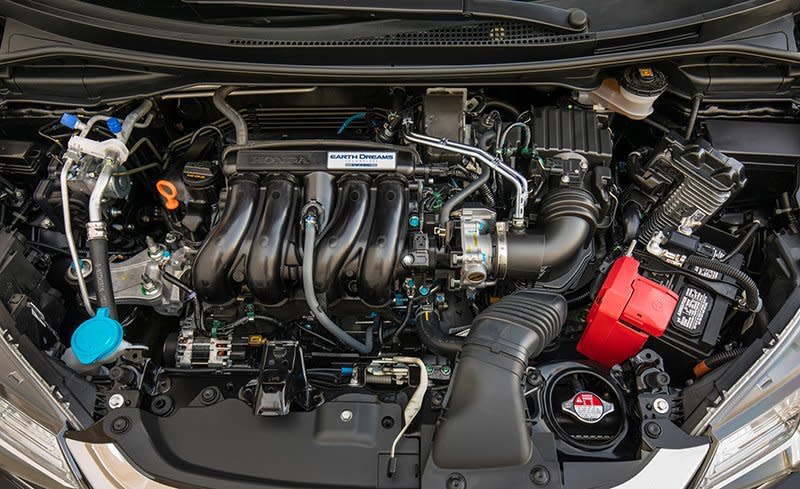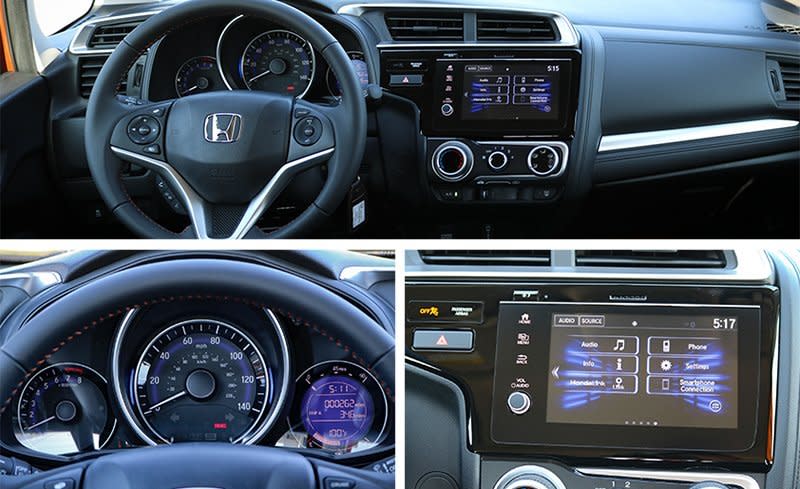2018 Honda Fit

The original Honda Fit was a prodigy when it burst onto the U.S. car scene as a 2007 model. With a vivid personality, an athletic chassis, and stunning space efficiency, it immediately embarked on a charm campaign that would win comparison test after comparison test, as well as a Car and Driver 10Best Cars trophy for seven consecutive years, well into its second generation. Alas, the latest Fit has been good if not quite great, handsomer than ever but sorely lacking its predecessors’ eagerness, dynamic refinement, and user-friendliness. Our 40,000-mile long-term 2015 Fit earned no shortage of complaints involving its unrelenting buzz at highway speeds, its tiny gas tank, the fussy infotainment system that lacked a volume knob, and lessened fun compared with its predecessors. Now a thorough mid-cycle enhancement for 2018 gives this third-generation Fit a second chance to make a first impression.
Our first drive of the 2018 Fit was hosted at Honda Performance Development in California, the R&D and technical-support center for the company’s prolific racing programs (including the SCCA B-Spec racing series that Honda spearheaded back in 2010 with the Fit race car). It’s also where the Fit’s natty new HPD chassis and interior bits were developed, accessories that found themselves onto some of the test cars we drove.
Fixing Fit
For 2018, Honda aimed to hone the Fit’s chassis to quell bobbing, reduce noise levels, enhance the steering’s linearity, and elevate its overall sense of nimbleness. Honda added structural braces around and under the body, swapped the shell-style steering pinion bearing for a solid one, and installed retuned dampers. It also used thicker acoustic materials inside the doors, wheel arches, and pillars, while new layers of soundproofing materials pad the dashboard and floor. To reduce wind noise, the new Fit gets an acoustically insulating windshield and thicker front quarter-windows. Remarkably, despite these refinements, weight is essentially a wash between the new and old cars, according to Honda.
Without a pre-refresh Fit on hand for comparison, it’s hard to measure the extent to which Honda achieved its ambitions. We can say, however, that the 2018 Fit EX-L we drove felt focused and planted as we swept along the Santa Clarita Valley’s rolling two-laners. As we hurled the Fit into tight corners, its body stayed calm and the 185/55R-16 all-season Firestone FR740 tires generally stayed glued to the pavement before gently breaking away at the limit into predictable understeer. Little additional steering feel seems to have resulted from the updates, unfortunately, yet the Fit traced our intended line with utter precision. All the while, it rode with suppleness and composure, more like a Civic sedan than a stubby hatchback.
We didn’t need any measuring devices to deem the additional cabin insulation a success. While the quietness somewhat clarifies the bleating 1.5-liter inline-four’s engine note—still not our favorite sound, especially as it moans when working with the optional continuously variable automatic transmission (CVT)—its lower overall volume no longer deters drivers from revving it all the way to its 6800-rpm redline. That’s a good thing indeed, considering one must hit 6600 rpm before all of the powertrain’s 128 or 130 horses (depending on transmission) show up.

Addressing two of our chief complaints is a new 7.0-inch Display Audio infotainment system that comes standard on Sport, EX, and EX-L models. Finally, it offers Apple CarPlay and Android Auto integration, and even better, the volume knob is back. While not all wrongs are righted with the 2018 Fit—the front seats still lack lateral support, and Honda wasn’t able to carve out any room for a larger fuel tank—there’s plenty to offset such woes. Along with a sophisticated-looking gauge cluster, there’s the Fit’s trademark 60/40 split rear Magic Seat, which lets you flip the lower cushion up to carry taller items or flop the seatback down, extending the Fit’s heroically low and flat cargo floor. Another big deal for the segment is the availability of the Honda Sensing driver aids on CVT-equipped models, which include not just forward-collision warning, automated emergency braking, and lane-keeping assist, but also road-departure mitigation and adaptive cruise control.
Also among the updates is the return of the Fit Sport model. Don’t get too excited, as it’s not actually any sportier, being a Fit LX that gets its own unique front spoiler and rear diffuser (both with orange accents), a, side-sill extensions, black 16-inch wheels, and a chrome exhaust tip. The Sport interior is accented with orange stitching on the leather-wrapped steering wheel and shift knob, plus the upgraded audio system found in the EX and above. Like the Fit LX, the Sport offers the Honda Sensing bundle of driver aids as an option; EX and EX-L trims get them standard.
The Fit with Kit
Curious to see what unrealized potential HPD could tap into with its suite of bolt-on accessories, we hopped into a Fit Sport with the six-speed manual gearbox in full HPD drag, including a 0.4-inch lowering kit, side skirts, black 16-inch wheels with two red-painted spokes, and a chunkier rear spoiler cantilevered off the back. Aluminum HPD pedals, red HPD floor mats, and a beautiful metal shift knob added visual punch to the Fit Sport’s cabin, already a kicky place with its “cross-hatch” upholstery and that orange contrast stitching. A similar package will be offered on non-Sport Fits, too, we’re told.

Not surprisingly, the HPD enhancements produced flatter handling and what felt like greater lateral grip—we’d love to put this version through our testing regimen—and the slicker feel of the shift knob had us making unnecessary gearchanges just so we could manipulate it. Now that we know how the 2018 Fit feels when adorned with such finery, we can’t imagine getting one any other way. In fact, with a bit more power, this could make a sweet halo model. Fit Si, anyone?
Honda declined to tell us how much its accessory packages will cost at this point. But we do know that the 2018 Fit’s sticker prices are between $100 and $160 higher than last year, depending on trim: Base LX models start at $17,065, Sport models come in at $18,375, and EX models cost $20,065—all with the manual transmission. Another $800 will equip any of those with a CVT automatic, while the Honda Sensing driver aids will cost LX and Sport customers another $1000. As mentioned, Honda Sensing is included on the CVT-equipped Fit EX as well as the $22,395 EX-L model, the latter offered only with the CVT.
Even last year’s slightly dulled Fit was easy for us to recommend to family and friends looking for real utility at an entry-level price, and this year’s upgrades make doing so easier. Is the new car good enough to earn the same adulation as the first two Fits? We’ll need to spend more time with it to find out.
Specifications >
VEHICLE TYPE: front-engine, front-wheel-drive, 5-passenger, 4-door hatchback
BASE PRICES: LX, $17,065;
Sport, $18,375;
EX, $20,065;
EX-L, $22,395
ENGINE TYPE: DOHC 16-valve inline-4, aluminum block and head, direct fuel injection
Displacement: 91 cu in, 1498 cc
Power: 128 or 130 hp @ 6600 rpm
Torque: 113 or 114 lb-ft @ 4600 rpm
TRANSMISSIONS: 6-speed manual, continuously variable automatic, continuously variable automatic with manual shifting mode
DIMENSIONS:
Wheelbase: 99.6 in
Length: 161.4–161.8 in
Width: 67.0 in Height: 60.0 in
Passenger volume: 95–96 cu ft
Cargo volume: 17 cu ft
Curb weight (C/D est): 2550–2650 lb
PERFORMANCE (C/D EST):
Zero to 60 mph: 7.7–9.1 sec
Zero to 100 mph: 22.7–25.6 sec
Standing ¼-mile: 16.8–17.1 sec
Top speed: 120 mph
FUEL ECONOMY:
EPA combined/city/highway: 31–36/29–33/36–40 mpg

 Yahoo Autos
Yahoo Autos 